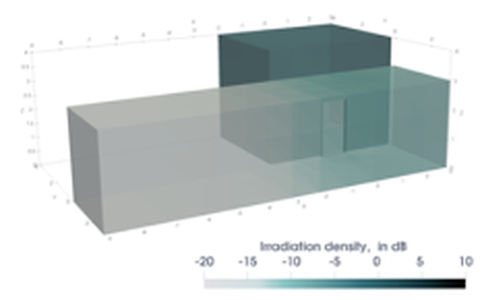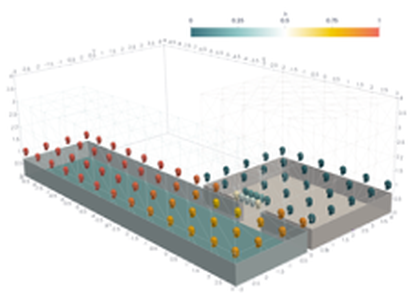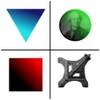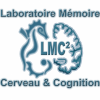RASPUTIN
RASPUTIN est un projet de recherche fondamentale collaboratif à l’intersection des « Sciences et Technologies du Numérique » et de la «Psychologie». Il vise à réduire la complexité cognitive de la navigation pour les non-voyants dans un nouvel environnement intérieur, et ce, grâce à des simulations numériques et des explorations en réalité virtuelle en audio 3D. Ces explorations permettent d’élaborer mentalement une carte cognitive de ces environnements encore jamais physiquement explorés.
L’enjeu technique principal du projet est de générer un rendu audio réaliste d’un édifice (auralisation) en temps réel en s’appuyant, d’une part, sur la librairie de spatialisation Spat~ et, d’autre part, sur la librairie Evertims dédiée à la simulation de la propagation acoustique dans un modèle numérique décrivant les paramètres architecturaux de l’édifice. La topologie des lieux d’intérêts nous a poussés à examiner comment les volumes couplés peuvent être simulés et auralisés de manière efficace.
Tout particulièrement, les propriétés de la réverbération tardive dans de tels lieux rendent l’auralisation délicate car elles impliquent l’utilisation de réverbérateurs à décroissance multi-exponentielle. Cette étude nous a donc amenés à proposer un tel réverbérateur, basé sur un réseau de retards rebouclés (FDN Feedback Delay Network), dont les caractéristiques de décroissance peuvent être contrôlées par des paramètres physiques traduisant les effets de couplage entre les volumes.
À cet effet, un modèle de radiosité acoustique a été proposé afin de rendre compte de l’hétérogénéité et de l’anisotropie de l’intensité acoustique réverbérée au sein de tels volumes et de sa dépendance en fonction de l’emplacement des sources et récepteurs. Le modèle permet notamment de contrôler la manière dont la puissance de la source est répartie entre les différentes entrées du réverbérateur selon sa position et son orientation dans le volume. De même, il est possible d’estimer comment les différentes sorties du réverbérateur doivent être pondérées pour obtenir le signal du récepteur.
Équipe : Espaces acoustiques et cognitifs


Modélisation de la distribution de l’intensité acoustique au sein du volume.
À gauche : distribution de la densité d’irradiation aux parois dans le cas de deux volumes couplés en régime de décroissance libre. De larges variations sont observables, notamment à proximité de l’ouverture. À droite : évolution du paramètre régissant la pondération relative des sorties du réverbérateur à décroissance multi-exponentielle en fonction de l’emplacement du récepteur. Des cartographies semblables peuvent être établies pour contrôler la répartition de la puissance d’une source vers les entrées du réverbérateur en fonction de son emplacement.











